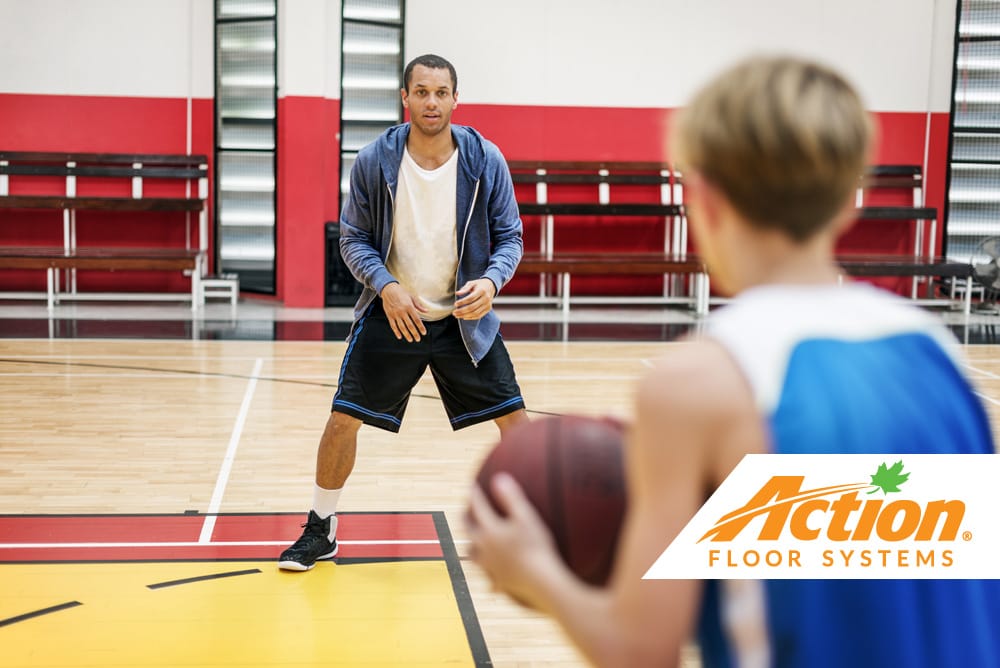
Student athletes may not give much thought to the flooring beneath their feet. However, the quality of the hardwood court inside a gymnasium, and the subfloor system it’s built upon, make a significant difference in competitive play, comfort, and safety.
As you examine your options in search of the right hardwood maple sports floor for your facility, you’ll come across terminology describing the way the floor performs. But, do you know why these attributes are measured and what they mean to you?
There are specific standards and testing procedures that measure sports floor performance. Understanding these characteristics helps schools and athletic facilities owners identify a system that fits the activities, budget, and expectations of coaches, athletic directors, and athletes.
Member mills of the Maple Flooring Manufacturers Association (MFMA), adhere to the associations’ Performance and Uniformity Ratings (PUR). Action Floor Systems® and others in the industry have spent generations working to improve the art and science of engineering a quality sports floor. The MFMA’s PUR Standards help define the relationship between a sports floors and athletes.
The following performance characteristics of hardwood maple courts are what sports flooring experts agree are the most important attributes to consider when choosing what to install in your facility.
Shock Absorption
What it measures: Also known as “force reduction,” shock absorption measures a sports floor’s response to impact by the athlete in comparison to that of concrete. It is evaluated under testing standard ASTM F2569-07. Test results showing higher force reduction values indicate a softer floor with more shock absorption.
Why it’s important: Shock absorption is a major contributor to playability. It makes a gym floor comfortable for athletes to use, and it can help protect the joints of lower extremities. While it is not considered a measure of safety, and there’s no definitive evidence that it reduces acute injuries, adequate shock absorption is easier on an athlete’s body. Appropriate shock absorption may also prevent athlete fatigue. Playing, competing, or exercising on flooring with poor shock absorption is more likely to result in sore knees and ankles.
The level of shock absorption a sports floor provides is determined by the floor material and design of the subfloor system. Ideally, a surface such as a basketball court provides consistent shock absorption throughout the floor.
High-quality hardwood courts, including Action Floors’ maple sports floors, have engineered subfloor systems, which means they are manufactured to provide ideal levels of shock absorption for activities such as basketball, aerobics, dance, and volleyball.
Vertical Deflection
![]() What it measures: When an athlete makes a downward action on a floor, the amount of downward movement during impact is known as vertical deflection or vertical deformation. It is measured and tested according to standards in ASTM F2157-09.
What it measures: When an athlete makes a downward action on a floor, the amount of downward movement during impact is known as vertical deflection or vertical deformation. It is measured and tested according to standards in ASTM F2157-09.
Why it’s important: Vertical deformation is considered an important attribute for sports such as basketball, volleyball, futsal, aerobics, and dance because it contributes to foot stability. The sports surface testing experts at ASET Services explain the difference between force reduction/shock absorption and vertical deflection/deformation.
“While force reduction is an attempt to simulate impacts during the ‘passive’ phase of a landing, vertical deformation is designed to examine the deflection of the surface during the entire impact which includes both ‘passive’ and ‘active’ response periods.”
Because these performance features are related, the higher the level of shock absorption the more vertical deformation occurs. Too much vertical deformation could result in a floor that feels unstable or slow to the athlete.
Area Deflection
![]() What it measures: The measurement of how energy is dispersed through a sports floor system is known as area deflection. It calculates the floor’s ability to contain the deflected area under an athlete’s impact, and it is also evaluated under ASTM F21157-09.
What it measures: The measurement of how energy is dispersed through a sports floor system is known as area deflection. It calculates the floor’s ability to contain the deflected area under an athlete’s impact, and it is also evaluated under ASTM F21157-09.
Why it’s important: ASET Services says the right area deflection value depends on the preferences of coaches and athletes. Installation methods and site conditions may also impact area deflection.
In general, area elastic hardwood courts with a subfloor system provide greater area of deflection while point elastic synthetic sports floors still provide shock absorption, but keep energy from an impact to a smaller area. Find out more about area and point elastic sports floors in a separate Sports Floor 101 article.
Ball Rebound
![]() What it measures: Ball rebound or bounce measures a basketball’s response to a sports floor system in comparison to how a ball bounces on concrete. So, a ball rebound test result of 100 percent would mean the ball bounces to the same height as it would on concrete. Ball rebound is evaluated by standards in ASTM F2117-10.
What it measures: Ball rebound or bounce measures a basketball’s response to a sports floor system in comparison to how a ball bounces on concrete. So, a ball rebound test result of 100 percent would mean the ball bounces to the same height as it would on concrete. Ball rebound is evaluated by standards in ASTM F2117-10.
Why it’s important: How well a ball bounces is obviously an important factor for many sports that may take place on a gym floor. Keep in mind, basketballs are always used to conduct performance testing for ball rebound. However, ball rebound test results are still valuable for determining the right system for different types of inflated balls.
The MFMA says ball rebound measurements for basketball courts should be around 93 percent at a minimum. There will be some give and take due to the relationship between ball response and shock absorption. A softer floor with higher force reduction values will yield a lower vertical ball rebound.
Surface Friction
![]() What it measures: This attribute relates to the finish on the sports floor surface than the hardwood maple flooring or subfloor system. Surface friction measures a floor’s ability to control surface friction or the slide of athletes. It is evaluated under standards in ASTM D 2047, and tests are conducted on a dry floor.
What it measures: This attribute relates to the finish on the sports floor surface than the hardwood maple flooring or subfloor system. Surface friction measures a floor’s ability to control surface friction or the slide of athletes. It is evaluated under standards in ASTM D 2047, and tests are conducted on a dry floor.
Why it’s important: For a sport like basketball, you need to have the right balance of slip resistance. Too little surface friction, and athletes will slip and slide on the floor, risking injury. But, basketball players do need some ability to slide on the court. Too much friction could also present problems.
Still Have Questions About Sports Flooring?
There are many things that go into manufacturing a high-quality hardwood sports floor system. While you may not need to be an expert, it helps to have some experts on your side.
In addition to testing for performance standards, Action Floors’ hardwood maple systems are also undergo tests for sustainability and indoor air quality (IAQ). All of our maple sports floors are FloorScore® certified through SCS Global Services, which means they produce low VOCs and support good IAQ as well as green building initiatives.
Action Floors is here to help you answer questions about sports flooring needs and the MFMA’s PUR Standards so that you can have important conversations with your general contractor and architect as you make decisions regarding sports surfaces in your building.
Action Floors provides hardwood sports courts to many professional venues as we offer FIBA-certified systems. We also specialize in manufacturing sports floor systems that are ideal for schools and athletic facilities of any size. Contact us with your questions or to request test results for any of our hardwood sports floors or Action Herculan synthetic sports floors.



















